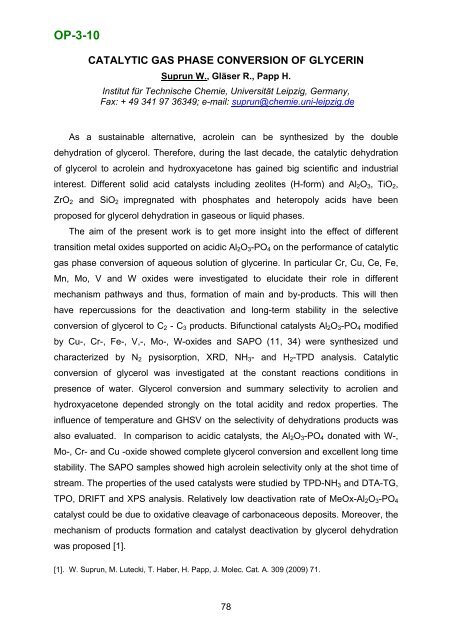Boreskov Institute of Catalysis SB RAS, Novosibirsk, Russia
Boreskov Institute of Catalysis SB RAS, Novosibirsk, Russia
Boreskov Institute of Catalysis SB RAS, Novosibirsk, Russia
- No tags were found...
You also want an ePaper? Increase the reach of your titles
YUMPU automatically turns print PDFs into web optimized ePapers that Google loves.
OP-3-10CATALYTIC GAS PHASE CONVERSION OF GLYCERINSuprun W., Gläser R., Papp H.Institut für Technische Chemie, Universität Leipzig, Germany,Fax: + 49 341 97 36349; e-mail: suprun@chemie.uni-leipzig.deAs a sustainable alternative, acrolein can be synthesized by the doubledehydration <strong>of</strong> glycerol. Therefore, during the last decade, the catalytic dehydration<strong>of</strong> glycerol to acrolein and hydroxyacetone has gained big scientific and industrialinterest. Different solid acid catalysts including zeolites (H-form) and Al 2 O 3 , TiO 2 ,ZrO 2 and SiO 2 impregnated with phosphates and heteropoly acids have beenproposed for glycerol dehydration in gaseous or liquid phases.The aim <strong>of</strong> the present work is to get more insight into the effect <strong>of</strong> differenttransition metal oxides supported on acidic Al 2 O 3 -PO 4 on the performance <strong>of</strong> catalyticgas phase conversion <strong>of</strong> aqueous solution <strong>of</strong> glycerine. In particular Cr, Cu, Ce, Fe,Mn, Mo, V and W oxides were investigated to elucidate their role in differentmechanism pathways and thus, formation <strong>of</strong> main and by-products. This will thenhave repercussions for the deactivation and long-term stability in the selectiveconversion <strong>of</strong> glycerol to C 2 - C 3 products. Bifunctional catalysts Al 2 O 3 -PO 4 modifiedby Cu-, Cr-, Fe-, V,-, Mo-, W-oxides and SAPO (11, 34) were synthesized undcharacterized by N 2 pysisorption, XRD, NH 3 - and H 2 -TPD analysis. Catalyticconversion <strong>of</strong> glycerol was investigated at the constant reactions conditions inpresence <strong>of</strong> water. Glycerol conversion and summary selectivity to acrolien andhydroxyacetone depended strongly on the total acidity and redox properties. Theinfluence <strong>of</strong> temperature and GHSV on the selectivity <strong>of</strong> dehydrations products wasalso evaluated. In comparison to acidic catalysts, the Al 2 O 3 -PO 4 donated with W-,Mo-, Cr- and Cu -oxide showed complete glycerol conversion and excellent long timestability. The SAPO samples showed high acrolein selectivity only at the shot time <strong>of</strong>stream. The properties <strong>of</strong> the used catalysts were studied by TPD-NH 3 and DTA-TG,TPO, DRIFT and XPS analysis. Relatively low deactivation rate <strong>of</strong> MeOx-Al 2 O 3 -PO 4catalyst could be due to oxidative cleavage <strong>of</strong> carbonaceous deposits. Moreover, themechanism <strong>of</strong> products formation and catalyst deactivation by glycerol dehydrationwas proposed [1].[1]. W. Suprun, M. Lutecki, T. Haber, H. Papp, J. Molec. Cat. A. 309 (2009) 71.78
















